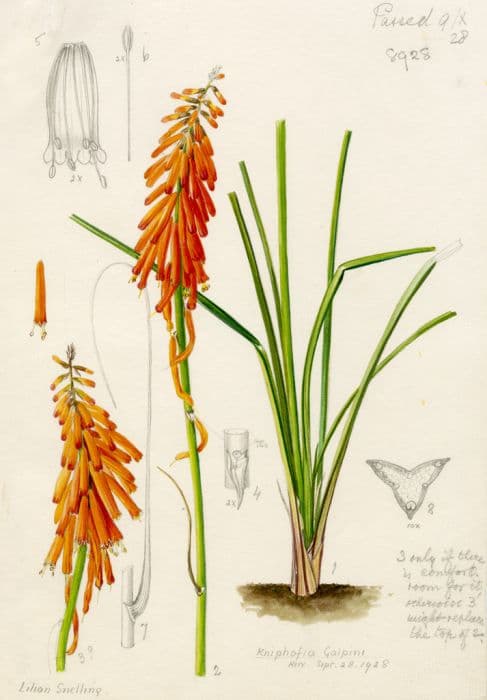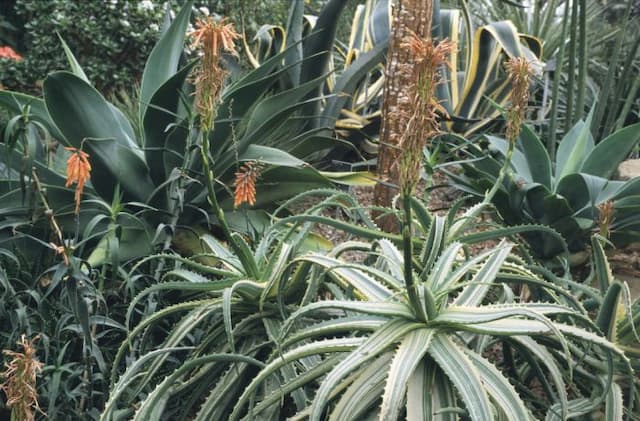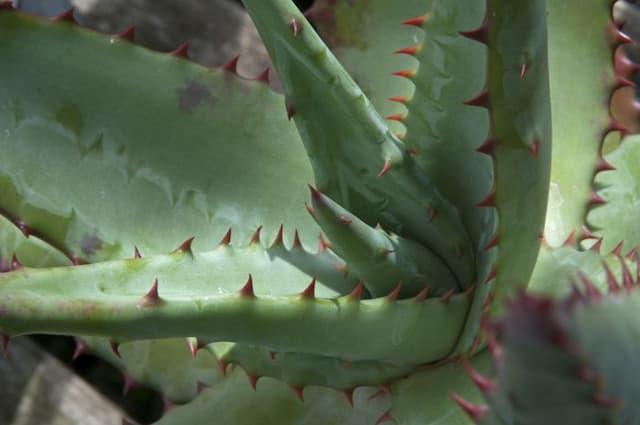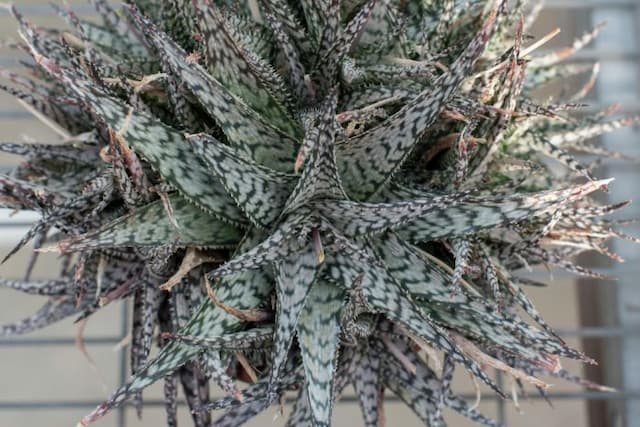Red Hot Poker Kniphofia galpinii Baker

ABOUT
The plant commonly known as "Orange Poker" or "Red Hot Poker" is a perennial with a striking appearance characterized by its vibrant, torch-like flower spikes. The flowers are typically arranged in dense inflorescences that give the plant its common names, exhibiting a gradient of hues from rich orange to yellow, often with a fiery look that attracts various pollinators. The bloom season introduces a bold splash of color to the garden, making it a standout among other plants. Beneath the flowers, the foliage consists of narrow, strap-like leaves that create a tufted cluster at the base of the plant. The leaves are usually a deep green color, providing a contrasting backdrop to the bright blooms. The texture of the leaves tends to be somewhat rough, adding to the plant’s architectural interest. Overall, the Orange Poker is celebrated for its vibrant flowers and ability to bring vertical interest and an exotic flair to the landscape.
About this plant
 Names
NamesFamily
Asphodelaceae
Synonyms
Galpin's Poker, Orange Poker, Red Hot Poker
Common names
Kniphofia galpinii Baker.
 Toxicity
ToxicityTo humans
Red hot poker (Kniphofia galpinii Baker) is not commonly known to be toxic to humans. However, as with any plant, individual allergies or reactions may occur. Handling plants can sometimes cause skin irritation or an allergic reaction. If ingested in large quantities, it may cause mild stomach upset in sensitive individuals. It is always advisable to avoid eating any part of ornamental plants due to potential risks that are not well documented.
To pets
Red hot poker (Kniphofia galpinii Baker) is not widely reported to be toxic to pets. However, ingestion of plant parts by pets, especially dogs and cats, may result in gastrointestinal upset such as vomiting or diarrhea. It is always prudent to prevent pets from consuming plants, especially in significant amounts, due to the potential for individual reactions or unidentified toxic compounds.
 Characteristics
CharacteristicsLife cycle
Perennials
Foliage type
Evergreen
Color of leaves
Green
Flower color
Orange
Height
3 feet (0.91 meters)
Spread
2 feet (0.61 meters)
Plant type
Herb
Hardiness zones
5
Native area
South Africa
Benefits
 General Benefits
General Benefits- Attractive to pollinators: Kniphofia galpinii, commonly known as Orange Poker, produces vibrant flowers that attract bees, butterflies, and other pollinating insects, contributing to the health of the ecosystem.
- Drought tolerance: Once established, the Orange Poker is quite resilient to drought conditions, making it suitable for water-wise gardens and arid environments.
- Landscape beautification: The striking orange flowers of the Orange Poker add aesthetic appeal to gardens and landscapes, providing a strong visual interest throughout its blooming season.
- Low maintenance: The Orange Poker generally requires minimal upkeep, with occasional watering and removing spent flowers to promote further blooming.
- Wildlife habitat: It offers nectar to pollinators and can be a part of wildlife-friendly gardens that aim to support biodiversity.
- Seasonal interest: The Orange Poker has a period of bloom that can add color to a garden when other plants may not be in flower, thereby extending the visual appeal of the landscape across seasons.
 Medical Properties
Medical PropertiesThis plant is not used for medical purposes.
 Air-purifying Qualities
Air-purifying QualitiesThis plant is not specifically known for air purifying qualities.
 Other Uses
Other Uses- As an ornamental element in rock gardens, the striking flowers of Red Hot Poker can add vertical accents and a burst of color.
- Red Hot Poker plants can be used as a natural barrier due to their size and dense growth habit, thus providing a physical deterrent in landscape design.
- The plant’s nectar-rich blossoms attract hummingbirds and butterflies, making them beneficial for pollinator gardens.
- Kniphofia galpinii, as a drought-tolerant species, is suitable for xeriscaping, contributing to water conservation efforts in landscaping.
- In photographic art, the unique inflorescence of Red Hot Poker makes for an interesting subject with vivid colors and distinctive form.
- The dried flowering spikes of Red Hot Poker can be incorporated into floral arrangements or used for crafting, providing a natural and rustic element.
- Red Hot Poker serves as a companion plant when paired with other sun-loving perennials to create contrasting foliage and bloom textures in garden beds.
- Some cultures may use the fibrous material from Red Hot Poker leaves for weaving small items like baskets, though this is less common.
- The Red Hot Poker plant can be used in educational settings such as botanical gardens, for teaching about plant adaptations and pollination strategies.
- When planted in mass, Red Hot Poker can act as a soil stabilizer on slopes or banks, helping to prevent soil erosion.
Interesting Facts
 Feng Shui
Feng ShuiThe Red Hot Poker is not used in Feng Shui practice.
 Zodiac Sign Compitability
Zodiac Sign CompitabilityThe Red Hot Poker is not used in astrology practice.
 Plant Symbolism
Plant Symbolism- Attention-grabbing: The bold and striking color of the Kniphofia galpinii, commonly known as the Red Hot Poker, makes it a symbol for standing out and grabbing attention.
- Vibrancy: With its vibrant orange and red flower spikes, Red Hot Pokers are often associated with liveliness and vibrancy, symbolizing a vibrant personality or life force.
- Passion: The fiery appearance of the flowers can symbolize passion, both in love and in one's pursuits.
- Courage: The plant's resemblance to a torch or poker can represent strength and courage, as it boldly rises and stands firm among the green foliage.
 Water
WaterRed hot poker plants, including the Kniphofia galpinii, should be watered regularly during their growing season, providing about 1 inch of water per week if rainfall is insufficient. During the peak summer heat, you might need to water twice a week, particularly if the soil is sandy and drains quickly. Reduce watering in the fall as the plant prepares for dormancy. Ensure that the soil is moist but not waterlogged, as overly soggy conditions can lead to root rot. It's best to use soaker hoses or drip irrigation to deliver water directly to the base of the plant, avoiding overhead watering that can promote fungal diseases.
 Light
LightRed hot poker plants thrive in full sunlight, so place Kniphofia galpinii in a location where it receives at least six hours of direct sunlight daily. The plant can tolerate partial shade, but flowering may be diminished in less than optimal light conditions. Ensure your red hot poker has unobstructed access to sunlight to promote healthy growth and abundant blooms.
 Temperature
TemperatureThe red hot poker plant prefers a temperature range between 50°F and 80°F, thriving in moderate to warm climates. Kniphofia galpinii can tolerate temperatures down to about 20°F but should be protected from severe cold, which can damage or kill the plant. Ideally, maintain an environment where temperatures rarely drop below freezing to ensure the plant's health and vigor.
 Pruning
PruningRed hot poker plants benefit from deadheading spent flower spikes to encourage further blooming. At the end of the flowering season, usually in late summer or early fall, cut back the flower stalks to the base of the plant. A more thorough pruning can be done in the spring; remove any damaged or dead foliage to maintain a tidy appearance and promote robust new growth.
 Cleaning
CleaningAs needed
 Soil
SoilRed hot poker plants like Kniphofia galpinii prefer well-draining soil with a pH range of 6.0 to 6.5. A good soil mix for these plants might include equal parts of garden soil, coarse sand, and peat or well-rotted compost to ensure proper drainage and aeration. Adding a slow-release fertilizer at planting time can provide nutrients for sustained growth.
 Repotting
RepottingRed hot pokers typically do not require frequent repotting and can remain in the same spot for several years. It is advisable to repot or divide Kniphofia galpinii every 3 to 5 years to rejuvenate and prevent overcrowding.
 Humidity & Misting
Humidity & MistingRed hot pokers, such as Kniphofia galpinii, are tolerant of a wide range of humidity levels. They do not require high humidity and are well-suited to the humidity levels typically found in temperate outdoor environments.
 Suitable locations
Suitable locationsIndoor
Place in bright light, water moderately, and ensure good air circulation.
Outdoor
Full sun, well-drained soil, protect from severe cold.
Hardiness zone
6-9 USDA
 Life cycle
Life cycleKniphofia galpinii Baker, commonly known as Orange Poker, begins its life cycle as a seed, which when provided with the right conditions of warmth and moisture, will germinate and sprout. The seedling emerges and establishes itself, developing a root system and foliage in the form of narrow, grass-like leaves. As the plant matures, it enters its vegetative state, where it focuses on growth, building up energy reserves in its rhizomes for flowering. Upon reaching maturity, which can take several years, the Orange Poker starts its reproductive phase usually in the summer, producing tall spikes with tubular, orange flowers that can attract pollinators like birds and bees. After pollination, the flowers develop into capsules containing seeds that, when mature, are dispersed to start a new generation. Lastly, the plant enters a period of dormancy in cooler months, although in warmer climates, it can remain semi-evergreen.
 Propogation
PropogationPropogation time
Spring to Summer
Propogation: Kniphofia galpinii Baker, commonly known as the Poker Plant, can be propagated effectively through division, which is ideally performed in the spring. To propagate through division, gardeners should carefully lift the clump from the ground once the risk of frost has passed and the soil can be worked with ease. Using a sharp spade or knife, the clump is then divided into smaller sections, ensuring each piece has at least one growth point. It's crucial to replant these sections immediately into well-draining soil, maintaining the same depth they were growing at previously. Regular watering after replanting helps the new divisions establish themselves more quickly, setting the stage for future growth and blooming.









